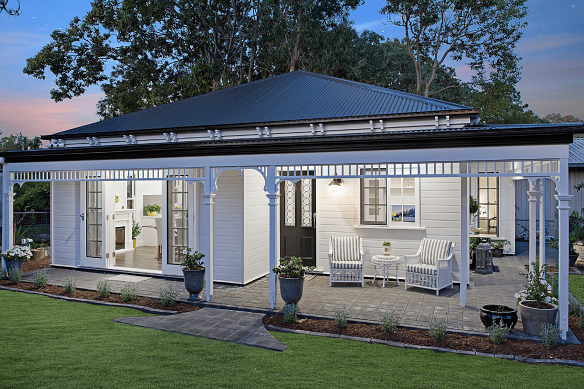- Perspective
- National
- Queensland
- Property development
This was published 11 months ago
Life in a tight spot not for all, but Brisbane homes might be heading that way
Few of us might ever own a Hampton-style home, but there could be a chance to rent a smaller version in someone’s backyard one day.
“The Hampton”, a 100-square-metre, two-bedroom granny flat from Brisbane-based design company Granny and Co, flips the stereotype of a backyard shoebox for ageing individuals, with finishes usually attached to a seven-figure price.

The Hampton, a two-bedroom granny flat by Granny and Co. Credit: Granny and Co
The custom build occupies little more space than the average granny flat, but is exemplary of a new era of aesthetically led second dwellings.
The “Marco Polo” from Brisbane-based architecture firm BAAHOUSE is another example.
This one-bedroom home occupies only 45 square metres but through clever design – high ceilings, a mezzanine bedroom and dynamic facade – it belies the modest space.
Condensing one’s life into a tiny home is not viable for everyone, but that could be where more of Brisbane’s market is heading.
Reports last week showed house and unit rents had reached records in Brisbane, with experts warning the city needed between 4000 and 8000 more rentals. At the same time, Brisbane’s vacancy rate was hovering at just 0.9 per cent, which was lower than a balanced rental market of 2 per cent to 3 per cent.
The recent Domain Rent Report was equally alarming, showing the price gap between renting a house and a unit in Brisbane had narrowed to $30 a week. (The median weekly rent for a house in Brisbane is $630 and for a unit $600.)
Secondary dwellings alone will not solve the issues, and housing experts are clear that we need a diversity of dwelling in every neighbourhood: units, terrace houses, townhouses and granny flats.
But with smart design changing attitudes and improving liveability issues, and legislation making them easier to access, the old-fashioned granny flat is entering a new era.
In September 2022, the Queensland government relaxed provisions to allow more granny flats – typically built to house family members – to be rented out to ease the tight rental market, with changes to be reviewed in three years.
Research published in October 2023 identified 184,660 granny flat development sites across Greater Brisbane, with 40.5 per cent of those landing in Brisbane’s LGA; 28.6 per cent within two kilometres of a train or light rail station; and 7.6 per cent in the same suburb as a hospital.
Those last two points are particularly important for frontline workers such as nurses who are increasingly being priced out of the housing market and further away from places of employment.
In Brisbane, homeowners don’t need planning approval from council for a secondary dwelling up to 80 square metres and within 20 metres of the main house, only building approval.
This makes specific data showing the number of secondary dwellings under construction or planned across Greater Brisbane difficult to pinpoint.
The pros and cons of building a secondary dwelling vary.
Granny flats can cost anywhere between $50,000 and $200,000 to build.
A secondary dwelling doesn’t automatically increase the capital value of a property, either. The structure and condition of the dwelling also impacts a property’s overall worth.
That said, other experts suggest a granny flat could add up to 30 per cent to the value of a property. You’d have to think The Hampton or Marco Polo would sit in that category.
The more immediate benefit is increased cash flow through rental returns. According to one estimate, a $160,000 build could attract $500 rent a week in some areas, which could amount to $26,000 a year.
That’s on the higher end of what would ideally benefit struggling renters, but there’s scope for this to be mutually beneficial in a tight rental market and for homeowners struggling with their mortgage and cost-of-living pressures.
At the start of 2023, I moved from a four-bedroom house into a 50-square-metre studio (and now live in a five-bedroom house).
Tenants have their own pros and cons to contend with: limited space and opportunities to host - and potential proximity to landlords - sit high on the cons list.
But for minimalists, certain workers, struggling renters, low-income earners or individuals sick of share houses, the pros can quickly outstrip the pitfalls. They just need to be available.